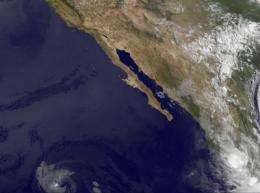GOES satellite sees Celia's remnants a shadow of her former self

The Geostationary Operational Environmental Satellite, GOES-11 captured a visible image of Celia's remnants on June 29 at 8:45 a.m. EDT revealing it to be a light swirl of clouds in the Eastern Pacific Ocean.
GOES-11 was launched by NASA and is now operated by the National Oceanic and Atmospheric Administration (NOAA). NASA's GOES Project at the Goddard Space Flight Center in Greenbelt, Md. created the latest satellite image that showed a very weak Celia.
Celia's remnant low pressure area had maximum sustained winds between 20 and 25 knots (23-28 mph) at 8:45 a.m. EDT this morning. Celia is quasi-stationary and is sitting near 15.5 north latitude and 123.5 west longitude in the open waters of the Eastern Pacific Ocean. Estimated minimum central pressure is 1007 millibars.
Showers were occurring this morning within 60 nautical miles over the eastern semicircle and within 120 nautical miles over the western semicircle. Celia is expected to gradually spin down and open into trough (an extended area of low pressure) by the end of the week. Tropically speaking, Celia is history.
Provided by NASA's Goddard Space Flight Center




















